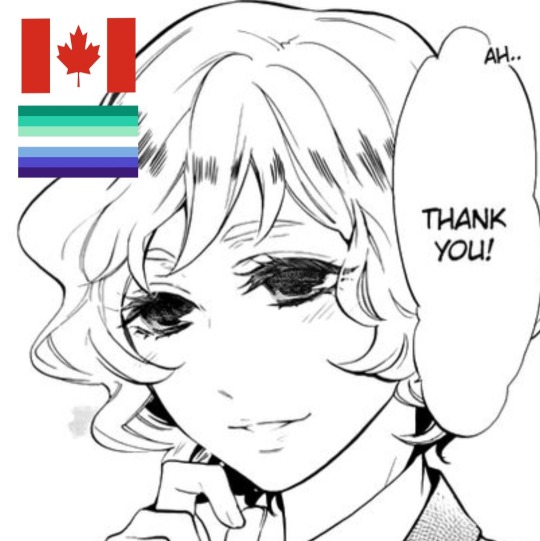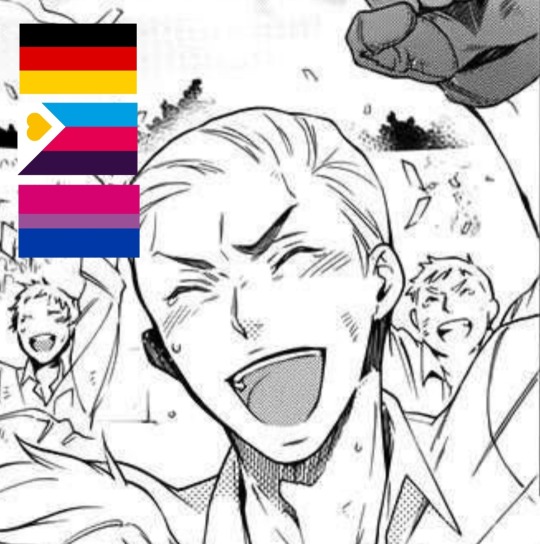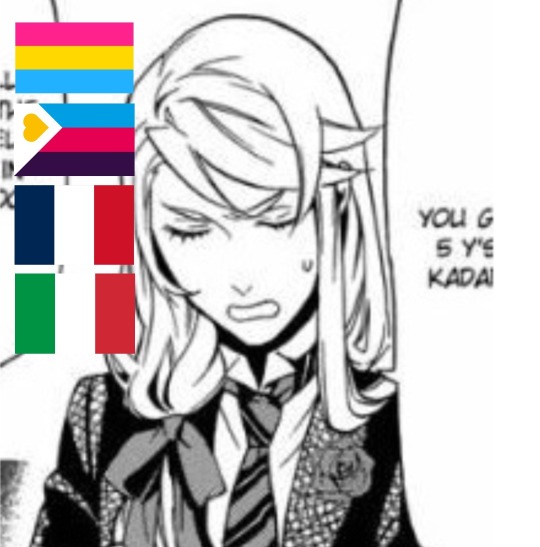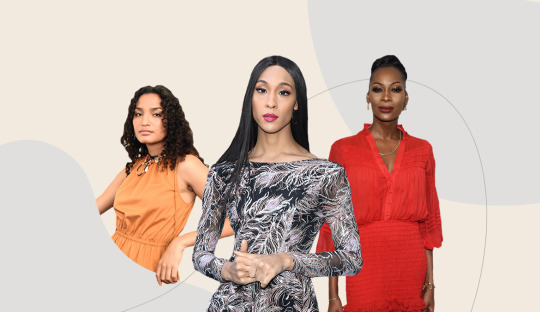#he portrayed Clayton and his personality so well and the behind the scenes pictures from him were incredibly charming and funny
Text
Some of my self indulgent headcannons










Some flags you may not know:
•Flag with the infinity symbol (Edward and Clayton)-> Autism
•Flag with the butterfly (Soma(and Elizabeth))-> ADHD
•Flag with the yellow heart (The P4)-> Polyamory
•Flag with blue and gray stripes (Joanne) -> demiboy flag
• Flag with the Black triangle (Gregory)-> Demisexual
#fun fact: the only reason why i started to headcannon Clayton as half japanese is because of his musical actor#he portrayed Clayton and his personality so well and the behind the scenes pictures from him were incredibly charming and funny#kuroshitsuji#black butler#kuroshitsuji season 4#vio speaks#joanne harcourt#gregory violet#maurice cole#edgar redmond#herman greenhill#lawrence bluewer#somaasmankadar#soma asman kadar#prince soma#edward midford#cheslock
76 notes
·
View notes
Text
Trans Inclusion On Screen Is Progressing—But to the Detriment of Black Trans People

This piece is part of Well + Good’s Healthy Mind vertical
“We’ve come a long way as trans actors,” claimed one of my fellow panelists during an LGBTQ+ actors’ workshop I was a part of. She wasn’t wrong, but it wasn’t the full picture.
“There is a gap, though,” I added. Yes, the portrayals of trans people on screen have improved from 20 years ago, when I watched the commodification of black trans women on TV shows like Maury and The Jerry Springer Show. But if “progress” is trans actors portraying trans characters on Sense8, Chilling Adventures of Sabrina, and Euphoria, then it seems to have come at the cost of Blackness.
I was a senior in college, and serving my second year as the theater club’s president, when screenwriter, director, and producer Ryan Murphy announced the cast of his show Pose would include trans femmes of color: MJ Rodriguez, Angelica Ross, Dominique Jackson, Indya Moore, and Hailie Sahar—all of whom are Black. As an Asian actress, I envied the actors and thought, Why not me?—which speaks to the collective misinterpretation of equity as a shortage of opportunities. My jealousy was greedy and unjust, insensitive to the pre-existing boxes and limitations of acting jobs for Black trans people.
Unprecedented casting aside, Pose still centered its characters’ stories at the intersection of being trans and Black. It wasn’t portrayals of gendered “trickery,” as it had been on Maury and The Jerry Springer Show, but the storytelling was still focused Black trans women’s pain.
Meanwhile, white actors are granted opportunities to tell stories that go beyond their gender. In Sense8, Naomi, played by Jamie Clayton, is a hacker in a fiercely committed interracial relationship with another woman. Although Naomi’s transness is acknowledged and honored, it is not the center of her story. In The Chilling Adventures of Sabrina, trans masculine and non-binary character Theo, portrayed by Lachlan Watson, has a brief scene of coming out to his friends, who effortlessly begin to use the pronouns “he/him”,” and it’s barely a plotline; he continues to be part of a larger story about Sabrina, a teenager caught in between her witch life and her mortal life. Both Naomi and Theo are white.
And in Euphoria, Hunter Schafer plays Jules, a high school student whose story acknowledges her transness intentionally, as a way of combating the possibility that others might dismiss her transness because of her privileges. During an interview with BUILD Series, Schafer herself acknowledged: “It doesn’t go without saying that I’m white, I’m skinny, and I pass.”
So, what does it mean to say things are better now for trans actors? It means disregarding the fact that white trans stories have profited from Black trans women’s struggle to be seen. It’s a false privilege to say “look how far we’ve come,” when “we” does not include Blackness and Black trans women still strive for the same nuanced progress in TV and film.
“The privilege of being a white trans character is that only the trans aspect needs addressing,” says James Robinson, LCSW, a Black and white biracial therapist in New York City who practices psychotherapy with artists, largely of color. He indicates, on the other hand, how the acknowledgment of race is a tightrope balance in itself. “It’s hard to portray Black characters in general; if they aren’t portrayed in experiencing trauma, then the audience might resist and the story might receive backlash because of a denial to that character,” says Robinson. “And if you do acknowledge their trauma, then in some ways the character becomes a monolith.”
As an Asian trans woman, I fall outside of the white trans representation, but as an actor, I have been able to benefit from the work of the Black trans women who showed themselves on screen before me. I felt this firsthand when Black trans women were in the audition room for a short film lead role that eventually chose to cast me. I’ve even been complicit in the ignorant celebration of white trans actors making their way in the industry as just “trans actors” and not “white trans actors.”
Psychologist Justin Hopkins, PsyD, who specializes in trauma-informed care for individuals whose identities are on the margins, says the issue is complex. “No trauma ever begets or justifies another trauma. There are simply varying degrees of pain that yearn and demand the fullness in which they are experienced,” he explains. “As white trans people recognize their desires to be visible, it is still harder for their black trans counterparts to have what [they themselves] thirst for.”
And the art of acting in itself plays a role in people’s personal hunger to be seen. “People pursue any types of jobs and passions in which they feel driven from a soul level,” Dr. Hopkins explains. “If you are someone who spent your life being invisible or having aspects of your core identity denied, it can feel incredibly rewarding, although demanding, to have a vocation where you are seen, praised, and affirmed under the bright lights. There is something satisfying and gratifying to the ego—perhaps necessarily so.”
It is no coincidence trans actors feel driven about their career; it is cathartic to deliver a performance and feel recognized in return, especially when celebrated in masses. However, that is no excuse for letting the trajectory of on-screen success irresponsibly move in a direction that leaves Black actors behind.
So, I want to ask trans actors who are not Black: What’s in it for you? Can you fight just as long and just as fiercely as you are now if you get nothing out of this? Can you agree you have been benefiting from the path Black actors paved?
This is not to say trans representation on-screen isn’t improving. It is crucial for non-Black trans actors to acknowledge the racial gaps in the progress. To fight for our Black trans kin and expect nothing in return. To acknowledge what it has taken to get to where we are in the industry. And, at the very least, to responsibly pay forward what is owed.
#healthy mind#well and good#well + good#psychology#twoc#trans women of color#POSE#POSE on FX#mj rodriguez#indya moore#dominique jackson#hailie sahar#angelica ross#janet mock#transgender#trans#mental health#trans representation#ego#actors#theatre#trans actors#euphoria#hunter schafer#the chilling adventures of sabrina#lachlan watson#sense8#jamie clayton#caos#caos 4
342 notes
·
View notes
Text
30 Years Later, ‘The Golden Girls’ is Still the Most Progressive Show on Television
“I had to write ‘Golden Girls’…I’ve never gotten excited about a network idea before, but this was compelling. I could write grown-ups.” — Susan Harris, creator of ‘The Golden Girls,’ September 1985
Picture it: Hollywood, 1985. The first episode of The Golden Girls airs, introducing the world to Blanche Devereaux, Rose Nylund, Sophia Petrillo, and Dorothy Zbornak. The show attracted more than 25 million viewers, becoming the highest-rated program of the week and consistently ranked in the top 10 sitcoms during its run. Over the course of seven seasons, the show racked up 68 Emmy nominations, 11 wins, and is one of only 4 shows in TV history whose principal actors all won Emmys for their roles. Despite Hollywood’s obsession with youth, The Golden Girls is still beloved by audiences thirty years after its premiere.
Beyond the fact that the show is extremely well-written and well acted (thanks to Bea Arthur, Estelle Getty, Rue McClanahan, and Betty White), The Golden Girls also stands out for being one of the last sitcoms where progressive values were part of the show’s DNA.
In an interview with Out Magazine, show creator Susan Harris explained, “We liked to tackle — not outrageous issues — but important issues. Things that I knew that people went through that hadn’t been addressed on television.” Harris was no stranger to shows that incorporated political story lines, having previously worked on Norman Lear’s groundbreaking All in the Family, and having written the historic abortion episode for Maude, which won her the Humanitas Prize — an award for film and television writing that promotes human dignity, meaning, and freedom. It is not surprising then that Harris brought this tradition to the writer’s room of The Golden Girls each week. The following are just some of the reasons why, after 30 years, The Golden Girls is still the most progressive show on television.
A Feminist Show
The very premise of The Golden Girls — four women navigating life after marriage and finding companionship in one another — is feminist in nature.While the women exchange quips and get into fights, the overarching message of the show focuses on the importance of chosen family, and women supporting other women. Further, we see the women enjoying life after marriage. Over the course of the series, we see the characters focus on career ambitions, new hobbies, and more often than not, their unapologetic enjoyment of sex. So much so that the blog Refinery29 recently tallied how many men each character slept with (naturally, Blanche had the most at 165). What made their love lives particularly important was the fact that television shows rarely portray older women as sexual beings.
The very premise of The Golden Girls — four women navigating life after marriage and finding companionship in one another — is feminist in nature.
“Television is always several steps behind life. When do you see passionate older people on television?” Susan Harris told The New York Times in a 1985 interview shortly after the show’s premiere. “There is life after 50. People can be attractive, energetic, have romances. When do you see people of this age in bed together? Eventually on this show, you will. It’s kind of pathetic that this show is television’s baby steps.’’
And the impact this had on audiences was clear. During an episode of The Phil Donahue Show, an adoring caller thanked guests Bea Arthur and Betty White for making her “feel 52 and gorgeous.” And the Winter 1989 issue of Media & Values magazine included survey responses from middle aged viewers of the show, such as one woman who responded, “I like this program because it gives me hope that there’s life after 50!” Beyond the message of female empowerment, the fact that the characters were older was significant in and of itself for the unprecedented portrayal of aging on television.
Portrayals of Aging
“Probably the single most effective product to come out of Hollywood in terms of turning around the cultural stereotypes about older women was the hugely popular and successful television show The Golden Girls in the late 1980s and early 1990s,” activist Ai-jen Poo wrote in her book Aging with Dignity. “Those four women, each with her own distinct history and personality…shattered the silence and the invisibility around aging in the most hilarious and endearing ways.”
While the entertainment industry pressures actresses to go to great lengths to maintain or restore their youth, The Golden Girls embraced aging and all the humor, wisdom, and vulnerability that comes with it.
This is evident in the episode “Rose Fights Back,” when Rose is cut off from her deceased husband’s pension plan and must find a new job. She is soon faced with age discrimination and the fear of not being able to make her rent. In a poignant scene, Rose discusses often seeing an older woman digging through the trash. She tells the other ladies, “I wondered, what did she do to get herself into a fix like that? I thought, well, she must be lazy, or she must be pretty stupid to let something like this happen to her. The truth is: she’s me.”
In another episode, Sophia makes a friend, Alvin, at the Boardwalk, but soon discovers that he has Alzheimer’s disease. She tells Dorothy, “people think if you live to be my age you should be grateful just to be alive. Well, that’s not how it works. You need a reason to get up in the morning and sometimes even after you find one, life can turn right around and spit in your face.”
While the entertainment industry pressures actresses to go to great lengths to maintain or restore their youth, The Golden Girls embraced aging and all the humor, wisdom, and vulnerability that comes with it.
Gay Rights
While the show’s message about women and aging is tied to its premise, The Golden Girls was often ahead of its time on other social issues. Twenty-four years prior to the U.S. Supreme Court’s historic ruling on marriage equality, The Golden Girls defended same-sex marriage before it was a mainstream position. In this episode, Blanche’s brother Clayton pays a visit and announces that he is engaged to his partner, Doug. In one scene, Sophia perfectly explains marriage equality to an upset Blanche:
In an interview with Vulture, show writer Marc Cherry recalled, “We were young writers, and we got to say a little something about gay rights and how gay people see themselves. It was about two men getting married, which is something people at the time didn’t talk about. And it was a really funny episode.”
Off the screen, the actresses were dedicated to advancing the cause of gay rights. At the height of the AIDS epidemic, which tragically hit the gay community, Estelle Getty was a staunch AIDS activist. In a 1989 interview, she explained, “I’ve been in show business all my life, and the majority of my friends are gay…A lot of my friends have died from AIDS.”
The show tackled the stigma surrounding AIDS head on in the episode “72 Hours,” and worked to counteract the myth that it was a gay disease or punishment. In the episode, Rose finds out she may have contracted the disease from an operation, and grows increasingly scared and angry. In one scene she exclaims, “This isn’t supposed to happen to people like me…I’m a good person!” Blanche argues back, “AIDS is not a bad person’s disease, Rose. It is not God punishing people for their sins.” The scene manages to be both humorous and raw.
Confronting Race
Much like the show did with gay rights, The Golden Girls confronted issues related to race in honest ways, rather than the imaginary “post-racial” interactions many sitcoms favor today. In one episode, Dorothy’s son Michael announces he’s getting married to Lorraine, a black singer in his band. The news causes Dorothy to cringe and cry out “Oh God,” but she recovers to explain that her race doesn’t matter. The scene portrays the complexity of prejudice, and dispels the idea that racism is something only “bad people” are guilty of — a recognition that is necessary in order to truly overcome prejudice.
Rarely is America’s complicated history with race woven into a sitcom storyline, much less as part of a white character’s backstory.
In another episode, we are introduced to Blanche’s “Mammy” from growing up, Viola Watkins. When Viola reveals that she had an affair with Blanche’s father, she explains, “In another time and place, we would have been married. But at that time in the South, it wasn’t an option.” The episode highlighted how often white children grew attached to their black caretakers, while underscoring the racial animosity that existed around them. Rarely is America’s complicated history with race woven into a sitcom storyline, much less as part of a white character’s backstory.
Disability Visibility
One subject matter that most television shows ignore altogether is disability. The Golden Girls, however, had multiple episodes revolving around characters with disabilities, usually as part of the women’s love lives. In these episodes, the women are forced to confront their own prejudices and misperceptions around what it means to be a person with a disability.
According to Lawrence Carter-Long, an expert on disability and media, “The best writing about disability focuses on character. Not a rehash of the same two-dimensional tragic or heroic movie-of-the-week stillness we’ve all seen a hundred times before.”
This sentiment is perfectly demonstrated in the episode “Stand By Your Man.” Blanche is nervous about dating Ted, a man in a wheelchair, played by Hugh Farrington, an actor who was paraplegic in real life. In the episode, Blanche gets past her prejudices and discovers that Ted is no different than anyone else, for better or worse. After learning that he has a wife, she says, “It never dawned on me that you could be a jerk in a wheelchair.”
In another episode, Rose is dating Jonathan Newman, a doctor at the grief center where she works. Rose is initially embarrassed to reveal their relationship because Jonathan is a little person, but she is determined to make it work. In the end, however, Jonathan breaks things off with Rose because she isn’t Jewish.
Fighting Poverty
Finally, as someone who does research and advocacy around fighting poverty, I am often frustrated by the myths and stereotypes that persist in film and television. The Golden Girls is not one of those shows. On many occasions, the show discusses poverty, but there is no better scene that demonstrates how well they did on the subject than in the episode “Have Yourself A Very Little Christmas,” when the ladies volunteer at a church to serve Christmas dinner to the homeless. They soon discover that Dorothy’s ex-husband, Stan, is among the people in need. The Church’s Reverend goes on to perfectly explain how poverty is an experience (rather than a moral failing, which is often the message), how public policy plays a role, and closes the scene with a direct jab at then-President Ronald Reagan:
REVEREND AVERY
You’d be surprised how many people are only two or three paychecks away from being on the street. The suddenly poor are all around us. Once you’ve been knocked down like that, it’s very hard to recover.
DOROTHY
What’s going to happen to all these people?
REVEREND AVERY
I don’t know. There’s no affordable housing, the rents keep going up and up, and the minimum wage has been held down.
ROSE
Seems so unfair.
REVEREND AVERY
Well, that’s because it is. There are three million homeless, hungry people in this country.
BLANCHE
What bothers me is, those people out there are being fed today because it’s Christmas, but what will they eat tomorrow?
REVEREND AVERY
When the great communicator talked about his vision of a city on a hill, I wonder if it included people sleeping on gratings in the street.
Over the past few years, many politicians have credited television for advancing their views on gay rights. And a growing body of research confirms that “as we grow emotionally attached to characters who are part of a minority group, our prejudices tend to recede.” In other words, television has the power to change the world. This makes what The Golden Girls accomplished even more critical. While the show wasn’t perfect on every issue, particularly on perpetuating hurtful plot lines around trans characters, The Golden Girls was an unapologetically progressive show. The show gave visibility to older women while using this unique platform to champion a number of progressive ideals that often go untouched by television shows. Not only is this level of progressivism unmatched on the small screen, the entire show was made possible by the understanding that older actresses have value and women can be funny.
The strength of the characters, the incorporation of storytelling, and punch lines delivered with a simple facial expression are among the many devices that make The Golden Girls one of the funniest sitcoms of all time. But it’s progressive message makes it one of the most important.
As a loyal fan, I’ll be celebrating the show’s 30th anniversary with my favorite episodes and a slice of cheesecake.
7 notes
·
View notes